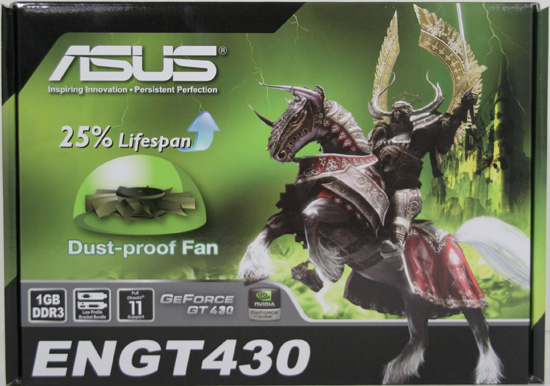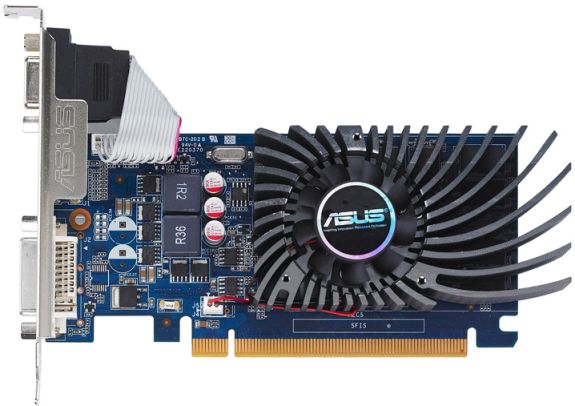NVIDIA's GeForce GT 430: The Next HTPC King?
by Ryan Smith & Ganesh T S on October 11, 2010 9:00 AM ESTMeet the Asus ENGT430
For our look today at the GT 430, Asus graciously provided us with their GT 430 card, the ENGT430. As with all the other cards being released it’s a custom design, featuring the usual Asus design elements: a double-sealed fan, fuse protection, and - while we have a hard time believing this is an issue on such a small card – GPU guard PCB reinforcement.
For this card Asus is very specifically going after the HTPC market. The ENGT430 is a half-height card with a low-profile bracket included, and for cooling it uses a decently sized heatsink with a particularly tiny fan we measure at 36mm. The heatsink does stick up some, so the card is explicitly a double-slot card and you’ll want to make sure you have space for it.
As is the case with low-end cards, reference clocks don’t tend to mean much. While the GT 430 has a reference speed of 700MHz for the core and 1.8GHz effective for the DDR3 memory, Asus has gone ahead and clocked the card at 1.6GHz for the memory. The card is equipped with 8 800MHz (1.6GHz effective) Hynix DDR3 memory modules running in 16bit mode, which is why the card is clocked below NVIDIA’s reference clocks. We expect to see memory clocks all over the place with the launch cards, depending particularly on who could get the best deal on what speed grade of DDR3 RAM for these cards. Given that GT 430 is likely already a memory bandwidth challenged card, this will have an impact, although we don’t have the means to measure it (our card would only go to 1.75GHz on the RAM).

For ports Asus is going with what’s undoubtedly going to be the universal configuration for low-profile GT430 cards: 1x DVI, 1x HDMI, and 1 VGA port. The DVI port is necessary for monitors (without resorting to a dongle), the HDMI port is necessary for HTPC roles, and the VGA port being an easy addition as an optional 3rd port due to its analog nature. GF108 can only drive 2 monitors at once, so the usual restrictions apply.
As is common for budget cards, there’s little else besides the card in the box. Asus includes the low-profile bracket, a multilingual quick installation guide, and a driver CD. This is the first Asus card we’ve reviewed for some time without voltage tweaking capabilities, so even NVIDIA’s integrated overclocking utility is enough for the task.












120 Comments
View All Comments
Spazweasel - Monday, October 11, 2010 - link
I think something very important is being missed in reviews of cards evaluated for HTPC use: the effects of the form factor of a case.Many HTPCs are in low-profile desktop-style chassis in an effort to visually integrate with the rest of home theater gear. Examples: Antec MicroFusion, nMediaPC HTPC 1080P, Lian Li PC36. These cases cannot accept standard-height cards, and must use low-profile-compatible (half height) cards. Additionally, the low profile of the cases severely inhibits airflow, which renders "open bench" and "inside a cavernous full tower case" thermal and acoustic testing largely irrelevant.
There are also HTPC cases which accept standard-height cards but are only barely tall enough to accommodate those cards, also impairing airflow, and are thus good test targets. Examples: nMediaPC HTPC 1000, Antec Fusion.
Therefore I suggest the following be added for consideration in any card which is ostensibly intended for an HTPC build:
1. Is the card available in low-profile designs?
2. For a given manufacturer's entry, is the low-profile bracket included?
3. Thermal testing and acoustic testing on low-profile cards performed in a low-profile case with all panels in place
4. Thermal testing and acoustic testing on standard-height cards performed in a case that is exactly as tall as a standard PC card, i.e. Antec Fusion, also with all panels in place.
5. Please report card-length. HTPC and other compact cases often have an issue with this.
Thanks very much!
ganeshts - Monday, October 11, 2010 - link
Thanks for the pointers. We will keep these in mind for future GPU reviews.1. Yes, the card is available in low profile designs, but it is dual slot because of the heat sink.
2. I only have a nV reference card, but Ryan has the Asus one. I will ask him about questions 2 - 5.
blastingcap - Monday, October 11, 2010 - link
"advertized"??AznBoi36 - Monday, October 11, 2010 - link
Come on AMD/Nvidia. Give us a cool running, low profile gaming card that is capable of playing games at 1080p and I'll buy it.Spazweasel - Monday, October 11, 2010 - link
Have you seen the PowerColor AX5750? It's a Radeon 5750-based card, 1gb DDR5, which is low profile. As far as I know, that's the most oomph you can get in a low profile card at present. 1080p gaming on a single 5750 would be marginal, near 30fps for moderate settings on most modern games, but if you can deal with that or don't mind pushing the sliders a bit to the left it may be doable. All depends upon your requirements. Sliders slammed to the right and 8x antialiasing? Not gonna happen :)If you need more, you can always try a Crossfire rig. In a low profile case that would be thermally brutal, however, and given that the PowerColor AX5750 uses a dual-fan cooling rig that does not exhaust out the back, two of them in a low-profile case might just be too much.
The good news is that the 5750 doesn't draw much power. Guru3D had a test that showed a 5750 Crossfire rig peaking at 401 watts, and that's with a much beefier CPU/motherboard setup (Core i7/965 OC to 3750mhz) than you would see in a typical HTPC rig. With something gentler like a standard-clocked Core i5 or Core i3, or a Propus 620e, you probably will never exceed 350 watts in a Crossfire setup, so you can stick to 450-500 watt PSUs in complete confidence for a pair of 5750. For a single 5750, a 350-400 watt unit (example: Antec's 380-watt PSUs that come with some of their cases) would be just fine.
fuzzymath10 - Monday, October 11, 2010 - link
I'm using the Powercolor 5750 Low Profile in an NSK1480 and that size of case is probably about as small as you'd want to go for gaming before stuff gets too hot and/or noisy. These cases often don't have the 6- and 8-pin power connectors you often need and dangling too many off molex adapters is a bit risky.However, it does run at good temps and quietly even overclocked from 700/1150 to 865/1265 and after slowing down the fan. It probably helps that I have two Noctuas, two Scythe S-flexes, and a very undervolted Q8200.
Spazweasel - Monday, October 11, 2010 - link
As far as case volume is concerned, I think the SFF form-factor companies like Shuttle are producing are actually smaller. But because those cases are taller and blockier, air has room to circulate over the top of cards; also, big noisy fans are more acceptable in an SFF gaming porta-rig than an HTPC in which silence is golden.Also, with LP cases, putting in a card effectively creates two new isolated compartments within a case (the card reaches from motherboard almost to to contact with the top cover, and from the back of the case almost to the front edge of the motherboard along the length of the card); air on one side of the card doesn't circulate with air on the other side of the card, and you're in trouble if either of those two new compartments doesn't have a robust source of cool air.
Per Hansson - Monday, October 11, 2010 - link
Hi, I guess this card would be the same as the announced nVidia Quadro 600?Guess maybe even my current uber crappy G84GL based Quadro 570 would be almost as fast...
That's one issue I see with GF108, sure here they are touting it as a HTPC thing, not for gamers
But it's ok to sell it as a Quadro and charging €200 for it instead?
Meh
http://www.anandtech.com/show/3961/nvidia-launches...
bearson - Monday, October 11, 2010 - link
Please beware of these cards from Asus. I have a GT220 which sounds like a helicopter and according to Asus the fan speed on these cards never speeds up or slows down. This seems to be confirmed in this article by looking at the idle vs load noise data.Thanks for a great site!
Best
softdrinkviking - Monday, October 11, 2010 - link
"At $80 the GT 430 goes up directly against the Radeon HD 5570 (DDR3 & GDDR5), sale-priced Radeon 5670s, the GT 430, and even the venerable 9800GT."Shouldn't this be "...priced Radeon 5670s, the GT 240, and even..."?